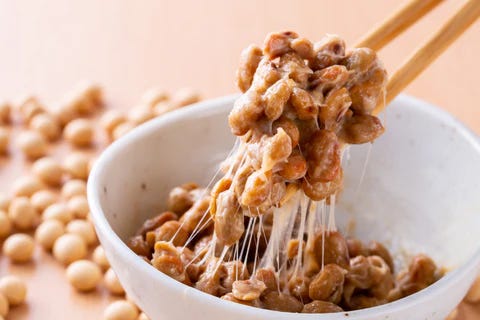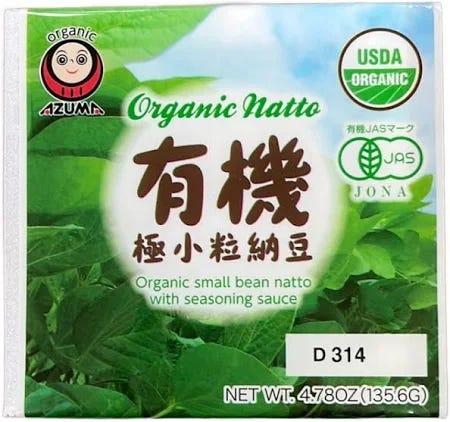Nattokinase: A Natural Ally for Brain Health in APOE4 Carriers
How a traditional Japanese enzyme may protect APOE4 carriers from silent strokes, inflammation, and Alzheimer’s pathology
When it comes to protecting brain health, those of us with the APOE4 gene have to be especially proactive. APOE4 increases risk for both Alzheimer’s disease and vascular dementia by influencing cholesterol handling, vascular integrity, and inflammation. This means we need strategies that support circulation, reduce inflammation, and prevent harmful protein buildup in the brain.
One natural compound that’s drawing attention in this area is nattokinase, an enzyme extracted from natto, a traditional Japanese food made from fermented soybeans. While it’s long been known for its cardiovascular benefits, research suggests nattokinase could also offer meaningful protection for the brain—particularly for APOE4 carriers.
What Is Nattokinase?
Nattokinase is a serine protease enzyme discovered in 1980, derived from the fermentation of soybeans with Bacillus subtilis natto. Unlike many enzymes, it remains active when taken orally and is well-absorbed in the gut. Traditionally, natto has been consumed for centuries in Japan, where stroke and heart disease rates were historically low.
Why APOE4 Carriers Should Pay Attention
Reducing Clot Risk and Supporting Microcirculation
APOE4 carriers are more prone to small-vessel disease and microinfarcts—tiny strokes that accumulate over time and accelerate cognitive decline.
Nattokinase has powerful fibrinolytic activity, meaning it breaks down fibrin (the protein that forms clots) and helps keep blood vessels open and flexible.
This ensures better delivery of oxygen and nutrients to brain cells, reducing silent vascular damage.
Lowering Blood Pressure
High blood pressure is one of the strongest risk factors for dementia, and it disproportionately affects APOE4 carriers.
Studies show nattokinase can gently lower blood pressure by reducing blood viscosity and improving vessel elasticity.
Reducing Neuroinflammation
Chronic inflammation is a hallmark of APOE4-driven Alzheimer’s.
Nattokinase has been shown to lower inflammatory cytokines and oxidative stress—two processes that accelerate neuronal injury.
Breaking Down Amyloid-Beta
APOE4 not only raises cholesterol transport issues but also impairs clearance of amyloid-beta—the sticky protein that forms plaques in Alzheimer’s.
Early lab studies suggest nattokinase can degrade amyloid fibrils, offering a potential way to reduce plaque burden. While this research is still in its early stages, it’s a promising mechanism.
Practical Considerations
Safety: Because nattokinase acts as a natural blood thinner, it should not be combined with anticoagulant or antiplatelet drugs (like warfarin, Plavix, or high-dose aspirin) without medical supervision.
Dosage: Typical supplemental doses range from 100–200 mg daily (2,000–4,000 fibrinolytic units). Clinical trials are ongoing to determine the optimal brain-protective dose.
Dietary Note: Eating natto itself is the most natural form, but the taste and texture are an acquired preference. Most people opt for capsules.
Eating Natto
You likely won’t find it in your neighborhood grocery store, but many larger cities have Asian or Japanese grocery stores where you will find it in the frozen foods section. This is the one I buy in Atlanta/Chamblee’s Japanese market.
Advantages:
Natural form: Natto provides not only nattokinase but also vitamin K2 (especially MK-7), probiotics, and peptides that support vascular and bone health.
Synergy: The combination of nutrients may enhance overall cardiovascular and brain protection.
Traditional evidence: In Japan, daily natto consumption correlates with lower rates of stroke and heart disease.
✘ Limitations
Taste/texture barrier: Natto is famously slimy and pungent, which many people can’t tolerate.
Dosage variability: The amount of nattokinase in food is not standardized, so you don’t know how much you’re getting.
K2 interaction: Because natto is rich in vitamin K2, it can interfere with anticoagulant drugs (like warfarin).
I’ve alternated between eating natto and the using the Nattokinase capsule over the years.
The Takeaway
For APOE4 carriers, protecting the brain means supporting vascular health, circulation, and protein clearance. Nattokinase checks all three boxes:
It improves blood flow.
It lowers blood pressure.
It calms inflammation.
And it may even help clear amyloid.
While more human trials are needed, nattokinase represents a promising addition to the APOE4 brain-protection toolbox—especially when combined with lifestyle strategies like a low-inflammatory diet, exercise, and good sleep.
✦ Bottom line: For those carrying APOE4, nattokinase isn’t just about heart health—it could be a valuable ally for preserving cognition and preventing Alzheimer’s disease.


